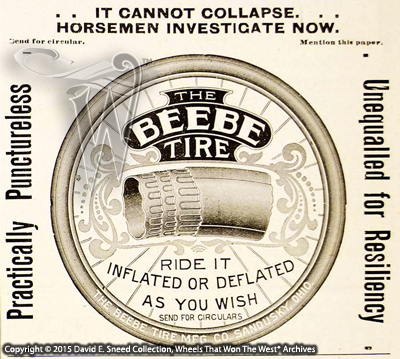Too often, it seems, significant contributions tied to the early wooden vehicle industry are overlooked, forgotten, or discounted as trite reflections from a non-relevant era. This week we're pleased to share another discovery that may help keep history books and modern perceptions in line with realities of early vehicle innovation.
While transportation designs have definitely changed over the years, many of the purposes and expectations haven't. In fact, as long as the wheel has existed, there have been challenges associated with keeping it rolling in good order.
To that point, many are familiar with a 21st century offering referred to as a 'run-flat tire.' These types of products are engineered to allow folks to continue driving on a punctured tire at lower speeds for limited distances. Ultimately, they're marketed as providing greater confidence, flexibility, security, and safety to contemporary drivers. As innovative as the concept may seem, though, it's far from being a new idea.
Looking back to the 1880's - yep the 1880's - we begin to see the first American patents related to pneumatic tires. Previously, wooden wagons and carriages were limited to the use of iron, steel, and hard rubber as a running surface (tire) for the wheel. The addition of pneumatictires to spring wagons, buggies, and carriages made for an even smoother, more comfortable ride.
Initial descriptions of the newly-developed pneumatic tires often stated that they could be inflated with air, gas, or liquid. (Incidentally, all three of these materials are still used within inflated tires today). By the 1890's, there were even more pneumatic tire patents introduced, with at least one touting a version of what we refer to today as a 'run-flat' tire.
 |
| This original advertisement from 1896 promotes the confident advantages of what we often refer to as a 'run-flat' tire. So much for new ideas in our modern age. |
During the 1890's, the Beebe Tire Manufacturing Company (shown in the advertisement above) was promoting this innovative new design through print advertising as well as editorials from trade publications. The text below is from an 1896 issue of "The Hub," clearly outlining the ability of this particular pneumatic tire to run flat without collapsing...
"A new carriage tire, known as the Beebe Pneumatic Vehicle Tire, manufactured by the Beebe Tire Manufacturing Co., of Sandusky,O., under patents of John D. Beebe, the patentee of the bicycle tire of that name, has created much interest among carriage men, who have looked in vain for a pneumatic carriage tire which was practical. This tire is made of alternate layers of rubber, fabric and crimped spring piano wire, in sufficient layers to make it puncture proof, as repeated tests have shown. Its construction prevents elongation and creeping on the wheel, and although the air in the tire adds to its resiliency, it is not absolutely necessary to the use of the tire. The great superiority of the tire lies in its ability to go for necessary distances even though punctured, since the wire prevents the possibility of a collapse."

Originally submitted in July of 1895, this patent for an early run-flat tire design was awarded to John D. Beebe in April, 1896.
So it was that roughly 120 years ago (as of this writing), the first pneumatic 'run-flat' tire was born. That will be a bit of news to at least one contributor to a popular on-line encyclopedic website. The writer in that case points to 1935 as the beginnings of the design. In spite of the well-meaning but flawed internet post, our research has uncovered a much earlier factory-made precursor to the idea. As we've shared here, the origins of the commercial "self-supporting" run-flat tire clearly began in the mid-1890s... four decades before the 1935 date mentioned and well in advance of what is often viewed today as a 'modern' invention. This, and so much more early transportation history, is typical of what we work so hard to find. From documented, primary source confirmation of legendary St. Louis wagon maker, Joseph Murphy's strict vehicle construction standards to first-hand verification of Studebaker's early paint designs and much, much more, we've been privileged to uncover a wealth of truths related to America's first transportation industry. Day in and day out, it's just part of our commitment to preserving and sharing so many rare parts of our country's past before they're forever lost.
By the way, if you haven't signed up to receive NOTIFICATIONS each time we post a new blog, article, or some other update to the Wheels That Won The West® website, it's easy. Just click on the SIGN UP link in the upper right of our website.
Please don't hesitate to let us know if we can be of assistance. We appreciate your continued feedback and look forward to sharing even more wooden vehicle info in the coming weeks.
Please Note: As with each of our blog writings, all imagery and text is copyrighted with All Rights Reserved. The material may not be broadcast, published, rewritten, or redistributed without prior written permission from David E. Sneed, Wheels That Won The West® Archives.